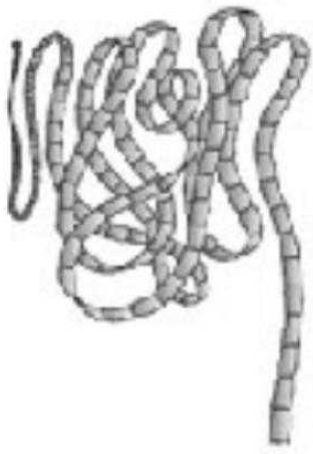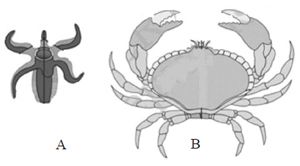Which of the following statement(s) is/are correct regarding phylum mollusca?
They are bilaterally symmetrical, triploblastic and coelomate animals.
Body is covered by a calcareous shell and is unsegmented with a distinct head, muscular foot and visceral hump.
The mouth contains a file-like rasping organ for feeding, called radula.
All of the above
Correct Answer :
D. All of the above
Mollusca are the second largest phylum after arthropoda and includes predominantly marine animals.
Related Questions
A student was given a specimen to identify on the basis of the characteristics given below.
(i) They are metamerically segmented.
(ii) Presence of closed circulatory system.
(iii) They have circular and longitudinal muscles for locomotion. Identify the specimen.
Prawn
Pheretima
Wuchereria
Ctenoplana
Which of the following group of animals reproduces only by sexual means?
Ctenophora
Cnidaria
Porifera
Protozoa
Which of the following characteristics is correct for reptilia?
Body covered with dry and cornified skin, scales over the body are epidermal, they do not have external ears.
Body is covered with moist skin and is devoid of scales, the ear is represented by a tympanum, alimentary canal, urinary and reproductive tracts open into a common cloaca.
Fresh water animals with bony endoskeleton and airbladder regulate buoyancy.
Marine animals with cartilaginous endoskeleton and body is covered with placoid scales.
Which of the follwoing statement(s) is/are correct?
(i) Organ systems in different group of animals show various patterns of complexities.
(ii) The digestive system in platyhelminthes has only a single opening to the outside of the body that serve as both mouth and anus, and is hence called complete.
(iii) In open type of circulatory system, the blood is pumped out of the heart and the cells and tissues are directly bathed in it.
(iv) In closed type, the blood is circulated through a series of vessels of varying diameters (arteries, veins and capillaries).
Only (i)
Both (ii) and (iii)
(i), (iii) and (iv)
All of these
Which of the following is a correct match of a phylum with their three examples?
PlatyhelminthesPlanaria, Schistosoma, Enterobius
Mollusca Loligo, Sepia, Octopus
Porifera Spongilla, Euplectella, Pennatula
Cnidaria Bonellia, Physalia, Aurelia
Which of the following statement(s) is/are correct regarding phylum mollusca?
They are bilaterally symmetrical, triploblastic and coelomate animals.
Body is covered by a calcareous shell and is unsegmented with a distinct head, muscular foot and visceral hump.
The mouth contains a file-like rasping organ for feeding, called radula.
All of the above
Which of the following belong to phylum arthropoda?
Bombyx and Apis
Laccifer and Anopheles
Locusta and Limulus
All of the above
Identify the figure with its correct name and phylum.

Sycon - Porifera
Aurelia - Coelenterata
Pleurobrachia - Ctenophora
Tapeworm - Platyhelminthes
The transition from aquatic to terrestrial lifestyles required many adaptations in the vertebrate lineage. Which of the following is not one of those adaptations ?
Switch from gill respiration to air-breathing lungs.
Improvements in water resistance of skin.
Alteration in mode of locomotion.
Development of feathers for insulation.
In ctenophora, the body bears _______ external rows of ciliated comb plates, which help in locomotion.
five
six
seven
eight
Flame cells present in platyhelminthes, are specialized in
respiration and absorption.
osmoregulation and circulation.
respiration and excretion.
osmoregulation and excretion.
Meandrina (brain coral) belongs to phylum
porifera
coelenterata
ctenophora
platyhelminthes
The organisms attached to the substratum generally possess
one single opening to the digestive canal.
cilia on the surface to create water current.
radial symmetry.
asymmetrical body.
In phylum echinodermata, the adult echinoderms are ______A__________ but larvae are _______B______ .
A radially symmetrical; B bilaterally symmetrical
A bilaterally symmetrical; B radially symmetrical
A bilaterally symmetrical; B asymmetrical
A metamerically segmented; B asymmetrical
Column-I contains organisms and column-II contains their exeretory structures. Choose the correct match form the options given below.
| Column- I | Column -II |
|---|---|
| (Organism) | (Excretory structures) |
| A. Cockroach | I. Nephridia |
| B. Cat fish | II. Malpighian tubules |
| C. Earthworm | III. Kidneys |
| D. Balanoglossus | IV. Flame cells |
| E. Flatworm | V. Proboscis gland |
A I; B III; C II; D IV; E V
A III; B I; C II; D V; E IV
A II; B I; C III; D V; E IV
A II; B III; C I; D V; E IV
The following statement are associated with the occurrence of notochord. Identify the incorrect statement.
It is present only in larval tail in ascidians.
It is replaced by a vertebral column in adult frog.
It is absent throughout the life in humans from the very beginning.
It is present throughout life in Amphioxus.
Tracheae of cockroach and mammal are similar in having
paired nature.
non-collapsible walls.
ciliated inner lining.
origin from head.
Polyp phase is absent in
Hydra
Aurelia
Physalia
Obelia
Identify the figure with its correct name and phylum.

Cucumaria – Echinodermata
Ascidia – Urochordata
Balanoglossus – Hemichordata
Hirudinaria – Annelida
The given figures of animals (A & B) are distinguished on the basis of symmetry. Select the correct option which shows the type of symmetry and its description against the animals.

A : Biradial, organisms is divided into unequal halves by any plane through the central axis.
B: Bilateral, body is divided into equivalent right and left halves by only one plane.
A: Asymmetrical, organisms is not divided into equal halves by any plane through the central axis.
B: Radial, in which any plane passing through the central axis of the body divides the organism into two identical halves.
The combination of a true coelom and repeating body segmentation allows the annelids (unlike the anatomically simpler worms) to do which of the following?
Attain complex body shapes and thus locomote more precisely.
Move through loose marine sediments.
Be hermaphroditic.
Inject paralytic poisons into their prey.
Refer the types of cells present in some animals. Each cell is specialized to perform a single specific function except
Cnidocytes
Choanocytes
Interstitial cells
Gastrodermal cells
Which of the following is not the common fundamental feature for animal classification?
Germinal layers.
Pathway of water transport.
Pattern of organization of cells.
Serial repetition of the segments.
Select the incorrect feature of mollusca from the given statements.
- Terrestrial or aquatic animals having cellular system level of organization.
- Radial symmetrical and acoelomate animals and possesses two germinal layers.
- A file like rasping organ called radula is present.
- Usually dioecious and viviparous animals.
- Examples include Pila, Octopus, and Dentalium.
(i) and (ii) only
(ii) and (iv) only
(i), (ii) and (iv) only
All the five statements.
Column I contains zoological names of animals and column II contains their common name. Match the following and choose the correct option.
| Column -I | Column- II |
|---|---|
| A. Physalia | I. Sea anemone |
| B. Meandrina | II. Brain coral |
| C. Gorgonia | III. Sea fan |
| D. Adamsia | IV. Portuguese man-of-war |
A III; B II; C I; D IV
A IV; B III; C II; D I
A IV; B II; C III; D I
A II; B III; C I; D IV
Identify the figures A, B and C and choose the correct option.

A - Male Ascaris, B - Hirudinaria (leech), C- Nereis
A - Female Ascaris, B - Nereis, C-Hirudinaria (leech)
A - Female Ascaris B- Hirudinaria (leech), C - Nereis
A - Male Ascaris, B - Nereis, C- Hirudinaria (leech)
Which of the following possesses poison sting and belongs to class chondrichthyes?
Labeo
Myxine
Clarias
Trygon
Refer the following animals and identify those which have a fluid filled body cavity with a complete lining derived from mesoderm.
(i) Sycon (ii) Butterfly
(iii) Nereis (iv) Sea fan
(v) Scorpion (vi) Pila
(i) and (iii) only
(ii) and (iv) only
(ii), (iii), (v) and (vi) only
All of these
Which of the following statement(s) is/are correct regarding class aves?
(i) The forelimbs are modified into wings and the hindlimbs generally have scales and are modified for walking, swimming or clasping the tree branches.
(ii) Heart is completely four-chambered.
(iii) They are warm- blooded (homoiothermous) animals i.e., they are able to maintain a constant body temperature.
(iv) They are oviparous and development is direct.
Both (i) and (iii)
Both (i) and (iv)
(i), (ii) and (iii)
All of these
Refer the following statement and answer the question. 'Name of X is derived from stinging capsules. It exhibits metagenesis containing two body forms in which sessile and cylindrical form is called Y and umbrella shaped and free swimming is called Z. Identify X, Y, and Z.
X - Coelenterate, Y - Polyp, Z - Medusa
X - Cnidarian, Y - Medusa, Z - Polyp
X - Ctenophora, Y - Radula, Z - Hypostome
X - Porifera, Y - Osculum, Z - Radula
